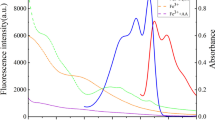Abstract
In this study, a sensitive and selective fluorescence nanoprobe has been designed based on carbon quantum dots modified by tungsten (WCQDs) for the detection of phenobarbital. Tungsten WCQDs were synthesized via a hydrothermal method using tungsten nitrate and glucose as a carbon source. The fluorescence signal of WCQDs was selectively increased by phenobarbital. The fluorescence increasing signal was applied for phenobarbital sensing at the pH = 8 without the interference of other materials. After optimizing the factors affecting the sensor’s response, a linear range between 25 and 500 µM with a detection limit of 5 µM was obtained. The sensor’s capability in the real-sample analysis was investigated by phenobarbital determination in human blood plasma samples.









Similar content being viewed by others
Data availability
The authors confirm the data of this study are available within the article.
References
J.B. Raoof, M. Baghayeri, R. Ojani, Colloids Surf. B Biointerfaces 95, 121 (2012)
Z. Es�haghi, Z. Rezaeifar, G.-H. Rounaghi, Z.A. Nezhadi, M.A. Golsefidi, Anal. Chim. Acta 689, 122 (2011)
M. Vosough, S. Ghafghazi, M. Sabetkasaei, Talanta 119, 17 (2014)
Y. Huang, S. Zhao, M. Shi, J. Liu, H. Liang, Anal. Chim. Acta 694, 162 (2011)
R. Shariati, B. Rezaei, H.R. Jamei, A.A. Ensafi, Talanta 194, 143 (2019)
F.L. Roveri, B.A.P.B. Paranhos, M. Yonamine, Forensic Sci. Int. 265, 75 (2016)
F. Ye, J. Pan, G. Hu, D. Lin, J. Zhu, X. Wang, Chromatographia 72, 743 (2010)
C. Karami, S.Y. Mehr, E. Deymehkar, M.A. Taher, Plasmonics 13, 237–544 (2018)
C. Karami, M.A. Taher, M. Shahlaei, J. Mater. Sci. Mater. Electron. 31, 5975 (2020)
J. Kneipp, H. Kneipp, B. Wittig, K. Kneipp, Nanomed. Nanatechnol. Biol Med 6, 214 (2010)
P.K. Jain, X. Huang, I.H. El-Sayed, M.A. El-Sayed, Acc. Chem. Res. 41, 1578 (2008)
Z. Lu, Y. Wang, X. Di, R. Cheng, L. Yang, P. Gao, Ceram. Int. 48, 5217 (2022)
R. Cheng, Y. Wang, X. Di, Z. Lu, P. Wang, M. Ma, J. Ye, J. Colloid Interface Sci. 609, 224 (2022)
E.A. Dil, M. Ghaedi, A. Asfaram, Talanta 202, 526 (2019)
J. Hou, H. Li, L. Wang, P. Zhang, T. Zhou, H. Ding, L. Ding, Talanta 146, 34 (2016)
G. Liu, Z. Chen, X. Jiang, D.-Q. Feng, J. Zhao, D. Fan, W. Wang, Sens. Actuat. B Chem. 228, 302 (2016)
C. Zhao, Y. Jiao, L. Zhang, Y. Yang, New J. Chem. 42, 2857 (2018)
H. Li, Y. Li, J. Cheng, Chem. Mater. 22, 2451 (2010)
Acknowledgements
We are grateful to the Department of Medical Science, Faculty of Sciences, Islamic Azad University, Sanandaj Branch, Sanandaj, Iran for their support for this work.
Funding
The authors have not disclosed any funding.
Author information
Authors and Affiliations
Contributions
All authors have contributed equally.
Corresponding author
Ethics declarations
Conflict of interest
The authors declare that there is no conflict of interest.
Research involving human participants and/or animals
The authors declare that there is no Research involving Human Participants and/or Animal.
Additional information
Publisher’s note
Springer Nature remains neutral with regard to jurisdictional claims in published maps and institutional affiliations.
Rights and permissions
About this article
Cite this article
Javadzad, H., Haghnazari, N. & Karami, C. Determination of phenobarbital in real sample using carbon quantum dots modified with tungsten as a fluorescent nanoprobe. J Mater Sci: Mater Electron 33, 12075–12082 (2022). https://doi.org/10.1007/s10854-022-08167-z
Received:
Accepted:
Published:
Issue Date:
DOI: https://doi.org/10.1007/s10854-022-08167-z




